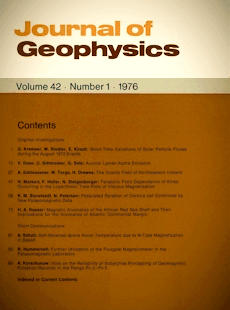Rayleigh channel waves for the in-seam seismic detection of discontinuities
Article Sidebar

Vols. 1-18 (1924-1944), ISSN 0044-2801
Main Article Content
Abstract
Two-dimensional seismic models are used to reproduce the geological sequence cheek-seam-cheek in deep coal mines. The known reflection method based on Rayleigh channel waves is investigated with respect to discontinuities being composed of a termination of the seam and a fractured zone outside the seam. By means of fractured zones having different reflection coefficients discontinuities are designed representing clay hogs or microtectonic faults. Results obtained by investigating amplitudes, frequencies and phase velocities show a strong increase of the rate of amplitude decay with decreasing phase velocity. Furthermore it is demonstrated that the part of the Rayleigh channel wave propagating outside the seam is responsible for the detectability of a discontinuity. Expressing the detectability numerically the ratio ER of the channel wave's energy inside the seam to its total energy has been used. The value 0.5 for ER is derived to be a standard value for distinguishing the phase velocity range for which reliable reflection surveys are possible (ER > 0.5) or not (ER < 0.5).
 ARK: https://n2t.net/ark:/88439/y015755
ARK: https://n2t.net/ark:/88439/y015755
Permalink: https://geophysicsjournal.com/article/107
Article Details
References
Arnetzl, H. (1971) Seismische Messungen unter Tage. Tagungsbericht der Gesellschaft deutscher Metallhutten-und Bergleute, 8.5., S. 133-141
Baule, H. (1967) Vorfelderkundung mit geophysikalischen Mitteln. Mitt. a.d. Markscheidewesen 74:205-228
Behrens, J., Waniek, L. (1972) Modellseismik. J. Geophys. 38:1-44
Brentrup, F.-K. (1970) Seismische Vorfelderkundung zur Ortung tektonischer Storungen im Steinkohlenbergbau. Gluckauf 106:933-938
Dresen, L. (1972) Modellseismische Untersuchungen zum Problem der Ortung oberflachennaher kreiszylindrischer Hohlraume in Festgestein, Berichte des Institutes fur Geophysik der Ruhr-Universitat Bochum, Nr. 1, Bochum
Freystatter, S. (1974) Modellseismische Untersuchungen zur Anwendung von Flozwellen fur die untertagige Vorfelderkundung im Steinkohlenbergbau, Berichte des Institutes fur Geophysik der Ruhr-Universitat Bochum, Nr. 3, Bochum
Krey, T. (1963) Channel waves as a tool of applied geophysics in coal mining. Geophysics 28:701-714
O'Brien, P.N.S., Symes, M.P. (1971) Model seismology. Reports on Progress in Physics 34:697-764
Postma, G.W. (1955) Wave propagation in a stratified medium. Geophysics 20:780-806
Schwaetzer, T., Desbrandes, R. (1965) Divergences constatees dans la mesure de la vitesse des ondes acoustiques longitudinales du charbon. Revue Inst. Francaise Petrol 20:3-26











